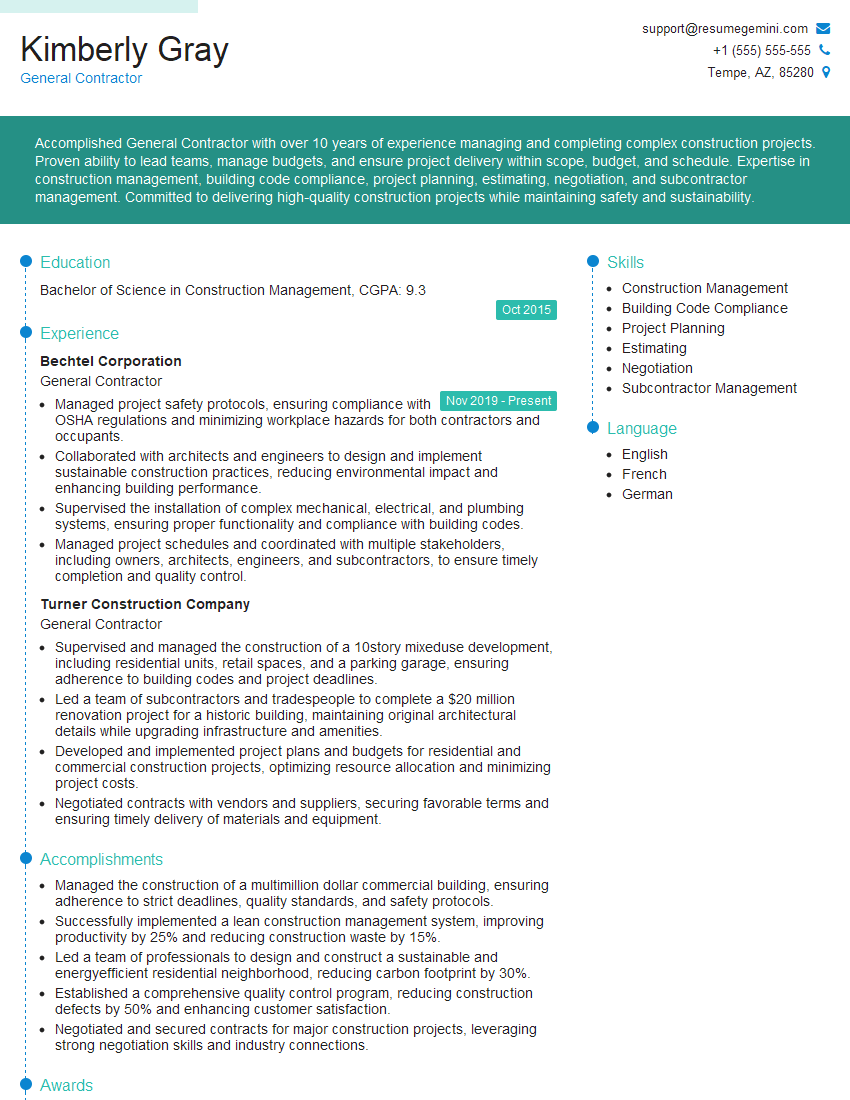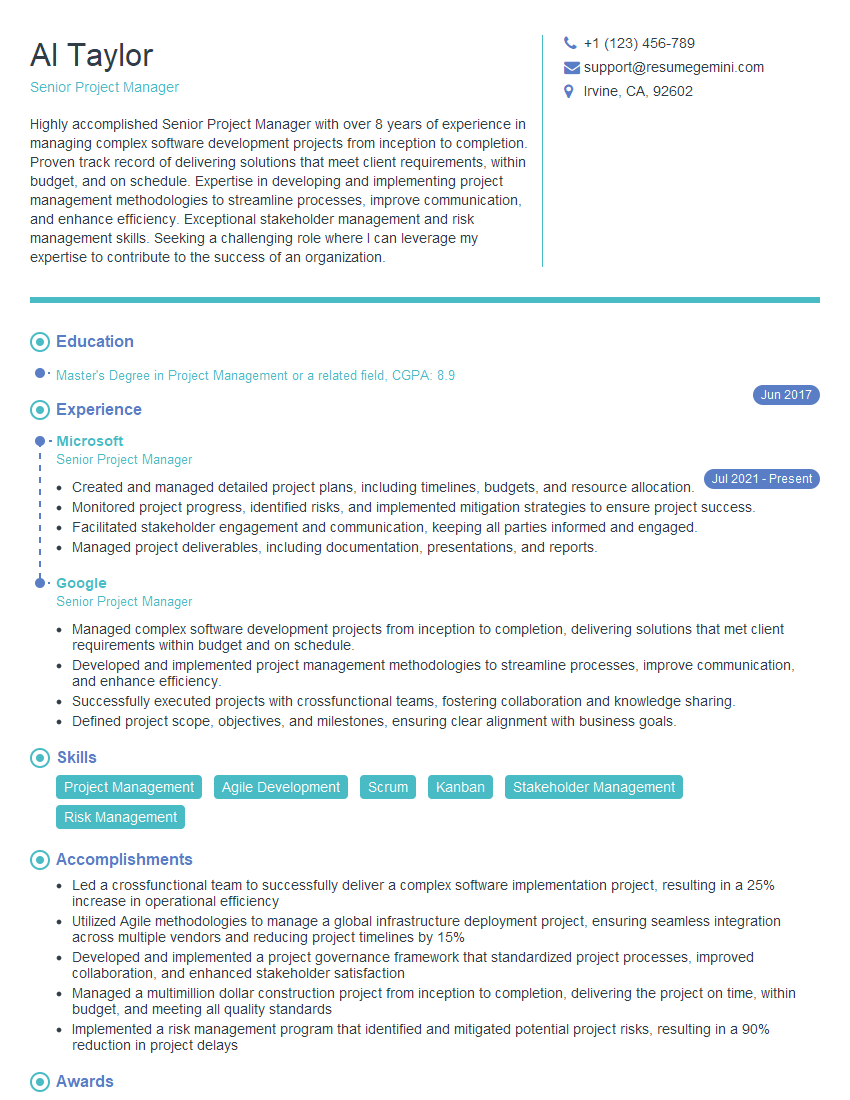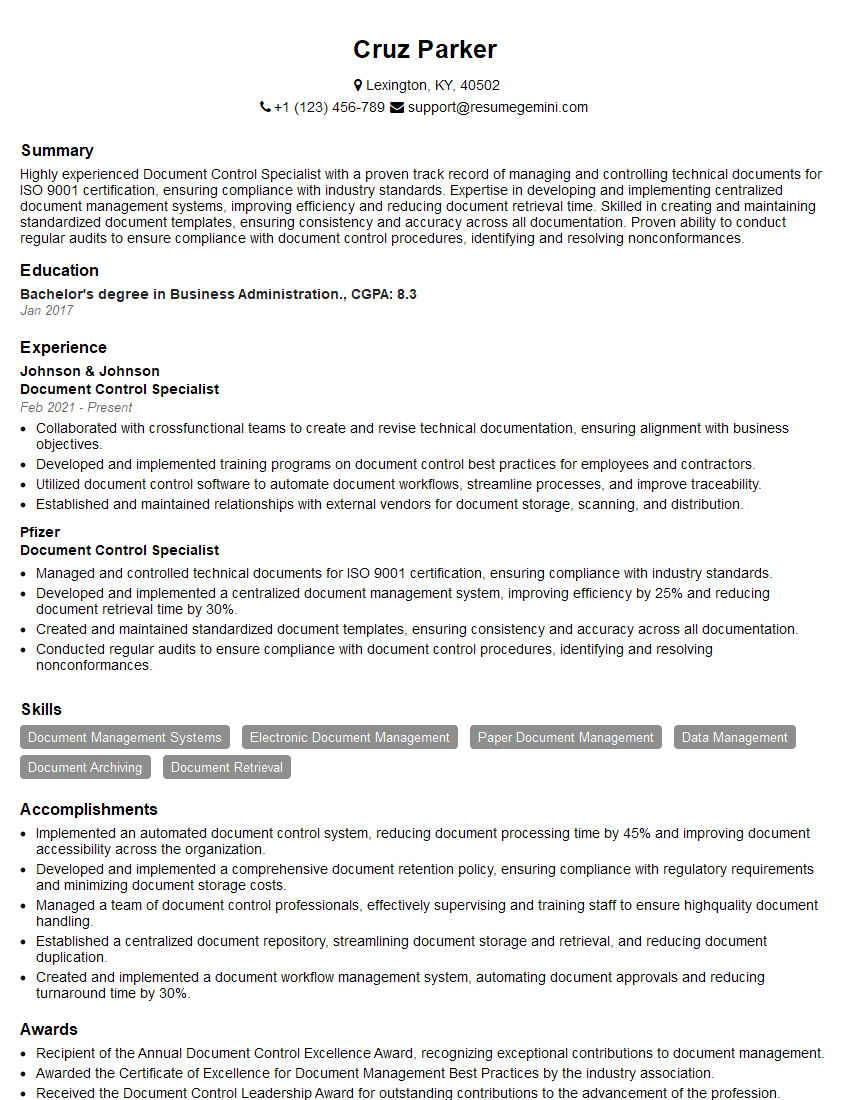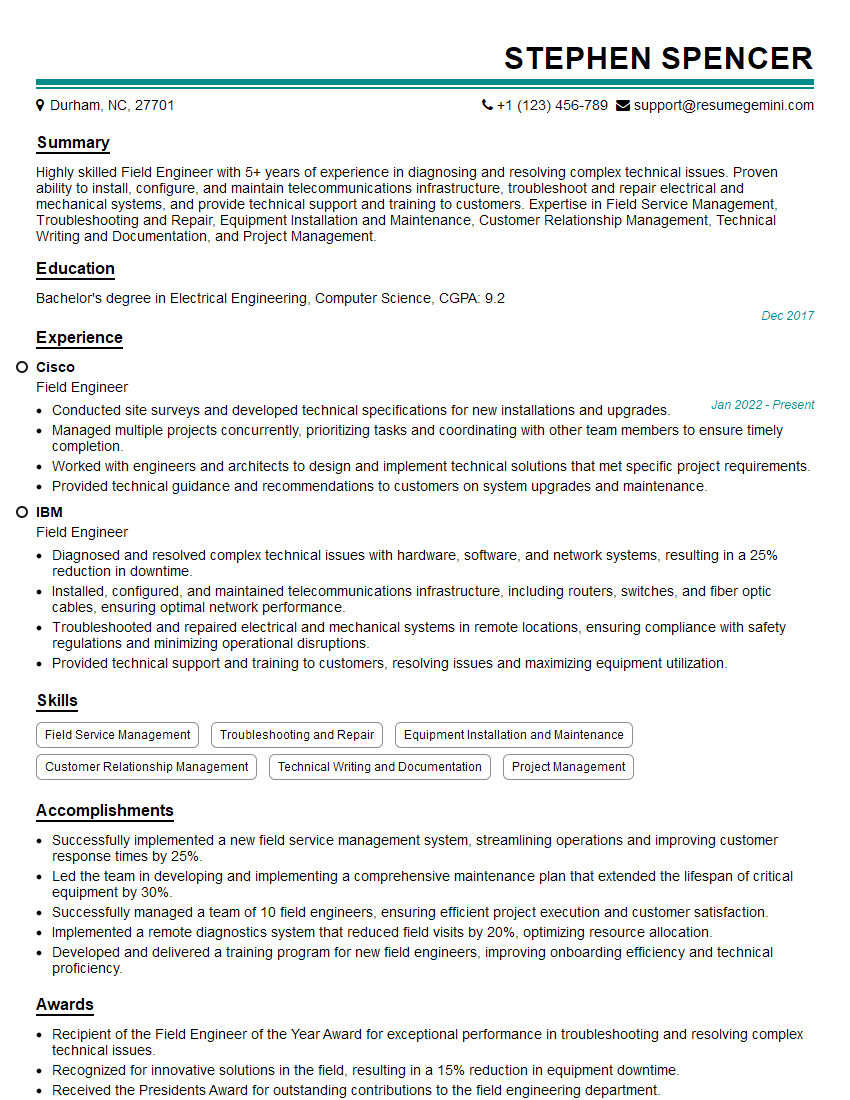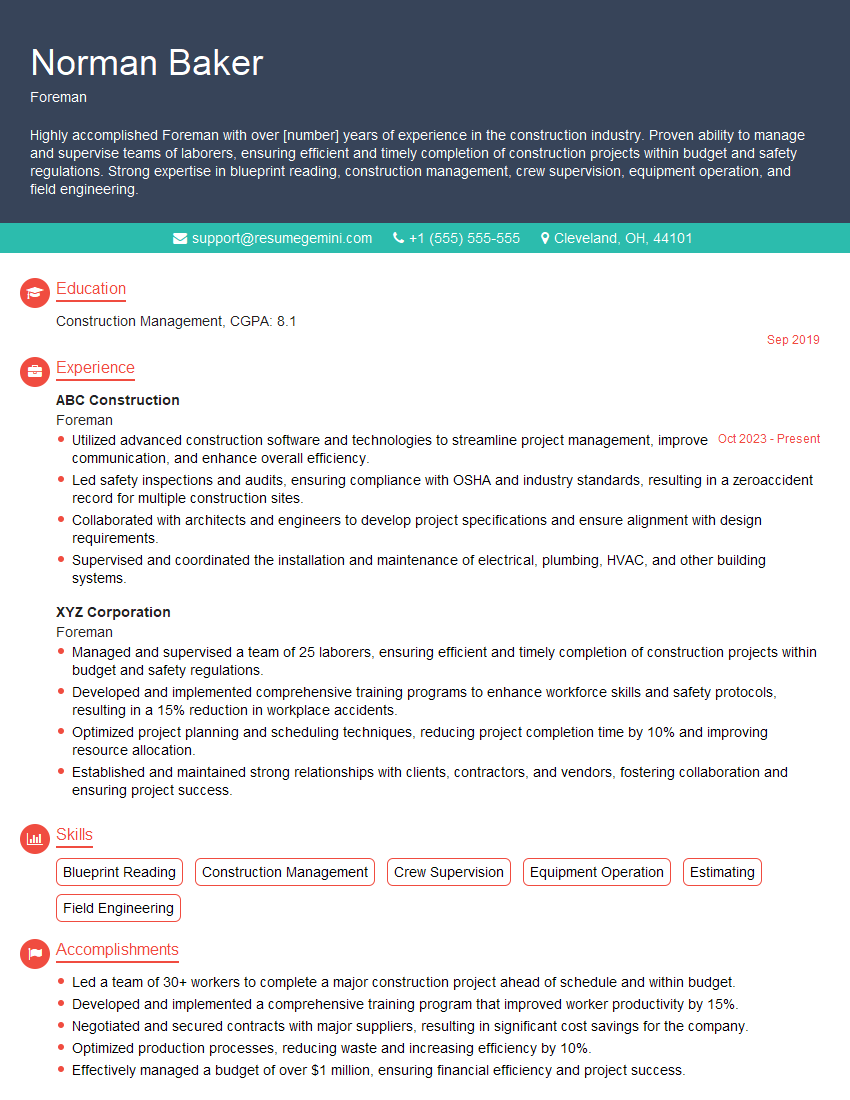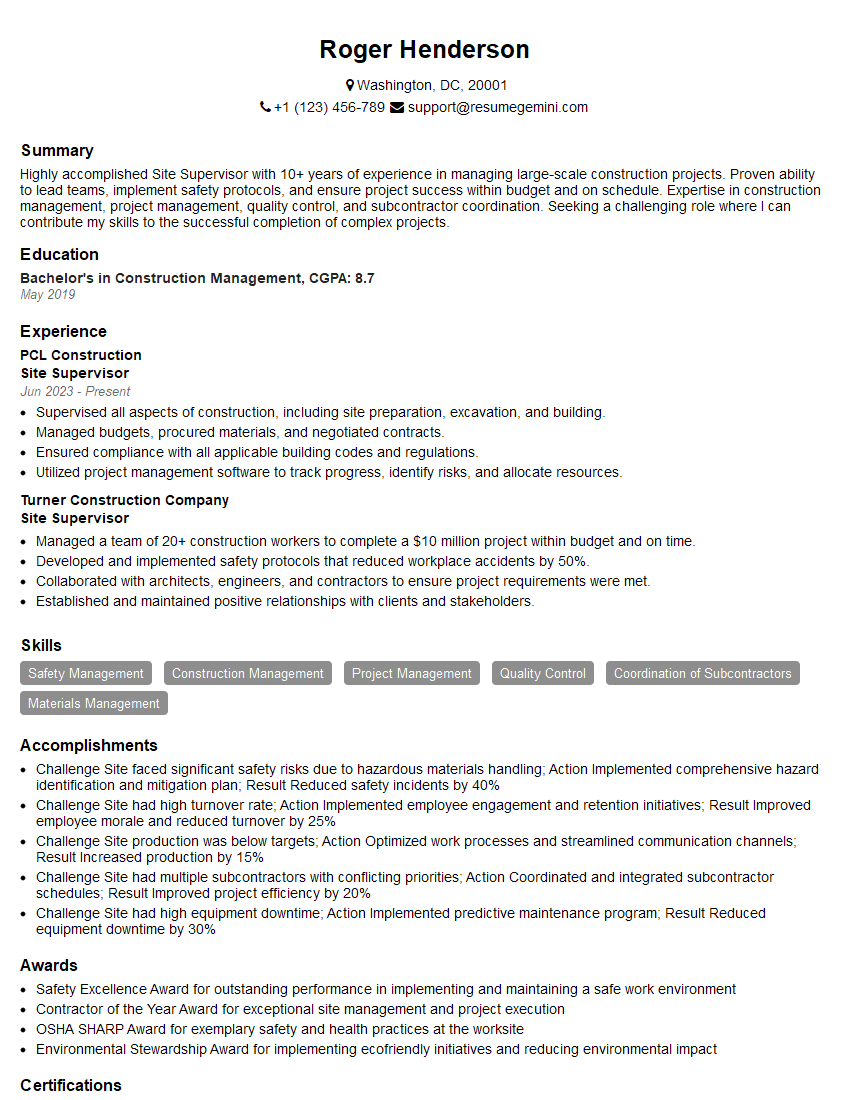The right preparation can turn an interview into an opportunity to showcase your expertise. This guide to Job Site Communication interview questions is your ultimate resource, providing key insights and tips to help you ace your responses and stand out as a top candidate.
Questions Asked in Job Site Communication Interview
Q 1. Explain your experience implementing a job site communication plan.
Implementing a job site communication plan involves a multi-stage process that begins with a thorough needs assessment. I start by identifying all stakeholders – from general contractors and subcontractors to architects, engineers, and even clients – and analyzing their communication needs and preferences. This includes determining the types of information they require, the frequency of updates, and their preferred communication channels. Based on this assessment, I develop a comprehensive plan outlining communication protocols, responsibilities, and escalation procedures. This plan typically includes a communication matrix clearly defining who is responsible for communicating what information to whom, and by which method (e.g., daily meetings, email updates, project management software notifications). For example, on a recent high-rise project, we utilized a daily log, email blasts for significant updates, and a dedicated project management platform for task assignments and progress tracking. This ensured everyone was informed and held accountable for their communication responsibilities.
The plan is then implemented and continually monitored for effectiveness. Regular review and adjustments based on feedback and project demands are crucial. It’s not a ‘set it and forget it’ approach; it’s an iterative process.
Q 2. Describe your approach to resolving communication breakdowns on a construction site.
Communication breakdowns on a construction site are often costly and disruptive. My approach focuses on proactive measures and reactive solutions. Proactive measures include the aforementioned communication plan and regular team meetings to address potential issues before they escalate. However, breakdowns still occur. When they do, I follow a structured approach: 1) Identify the root cause: Is it a lack of clarity in instructions, insufficient information sharing, conflicting information, or personality clashes? 2) Gather information from all involved parties to get a complete picture. 3) Facilitate a collaborative problem-solving session, fostering open communication and a non-confrontational environment. 4) Document solutions and implement corrective actions, potentially modifying existing communication protocols or providing additional training. For instance, on a recent project, a miscommunication between the electrical and plumbing subcontractors led to schedule delays. By bringing them together, clarifying the design specifications, and providing visual aids, we were able to resolve the issue and prevent similar problems in the future.
Q 3. How do you ensure all team members receive crucial project updates in a timely manner?
Ensuring timely updates requires a multi-faceted strategy. First, I leverage various communication tools, like daily stand-up meetings, project management software (e.g., Asana, Monday.com), email updates, and even text message alerts for urgent situations. Second, I establish clear reporting lines and responsibilities, ensuring everyone knows who is responsible for providing updates and to whom. Third, I use a centralized hub, whether that’s a project management platform or a shared document repository, where all crucial information is stored and easily accessible. Finally, I regularly check in with team members, not just to receive updates, but also to ensure they understand the information provided. Think of it like a well-oiled machine; each part needs to perform its function consistently for the whole system to work smoothly.
Q 4. What methods do you use to effectively communicate complex technical information to non-technical personnel?
Communicating complex technical information to non-technical personnel requires simplification and visualization. I avoid jargon and technical terms whenever possible, replacing them with plain language and analogies. Visual aids, such as diagrams, charts, and even simple sketches, are incredibly effective in conveying complex concepts. I also break down complex information into smaller, easily digestible chunks, and I always encourage questions to ensure understanding. For instance, explaining the intricacies of a reinforced concrete design to a general laborer might involve showing a simplified diagram highlighting the rebar placement and explaining its function in simple terms. Interactive sessions, perhaps using a model, can further enhance comprehension.
Q 5. How do you handle conflicting information from different subcontractors?
Conflicting information from subcontractors is a common challenge. My approach is to convene a meeting involving all affected parties, including the relevant design professionals. The goal is to objectively review the conflicting information, identify the source of the discrepancy, and determine the most accurate and compliant solution. This often involves referencing the original design documents, specifications, and relevant building codes. Open communication and a collaborative problem-solving approach are vital in resolving these conflicts. It’s crucial to establish a clear chain of command and decision-making process to avoid further confusion. The goal isn’t to assign blame but to find a solution that ensures project safety and compliance.
Q 6. Describe your experience using communication tools like radios, email, or project management software.
My experience encompasses a wide range of communication tools. Two-way radios are indispensable for real-time communication on a bustling job site. Email serves as a reliable method for formal communication, project updates, and distribution of documents. Project management software is a cornerstone of our approach, centralizing tasks, schedules, and progress reports. I’m proficient in several platforms, including Asana, Monday.com, and Microsoft Project. Selecting the appropriate tool depends on the specific communication need; for instance, radio is ideal for immediate updates on safety concerns or logistical changes, while email is better for formal documentation, and project management software handles task delegation and progress tracking. I choose tools based on their effectiveness for specific situations and the team’s familiarity with them.
Q 7. How do you maintain clear and concise communication during emergency situations?
Maintaining clear and concise communication during emergencies is paramount. Our protocols emphasize direct, unambiguous language. We use pre-established communication channels, with clear escalation procedures in case of failure. A designated spokesperson manages information flow to prevent confusion. A clear chain of command dictates who makes decisions and provides instructions. Emergency response plans are frequently rehearsed to ensure everyone is familiar with their roles and responsibilities. The key is clarity, brevity, and a focus on safety. For example, during a fire, clear instructions and direct communication through the designated channels would ensure everyone knows the evacuation procedures and assembly point, minimizing the risk of panic and confusion.
Q 8. How do you ensure that all safety information is clearly communicated to workers?
Ensuring all safety information reaches workers requires a multi-pronged approach. It’s not enough to just post a notice; you need to confirm understanding. Think of it like teaching a crucial skill – you demonstrate, explain, and then assess comprehension.
- Multiple Communication Channels: We use a combination of methods: safety meetings (toolbox talks), visual aids (posters, videos at strategic locations), written materials (handouts in multiple languages), and digital platforms (if appropriate for the workforce).
- Regular Refresher Training: Safety isn’t a one-time event. We incorporate safety reviews and training into daily operations, especially before starting high-risk tasks. This reinforces critical information and addresses any emerging safety concerns.
- Verification of Understanding: Simple quizzes, brief verbal confirmations, or even observation of workers performing tasks safely help to confirm understanding. We’ll even role-play scenarios to test their awareness of protocols. This isn’t about testing, it’s about verification and correction.
- Feedback Mechanisms: We encourage workers to report near misses or unsafe practices without fear of reprisal. This creates a culture of safety where open communication is valued.
For example, before starting demolition work, we conduct a thorough toolbox talk, showing a video depicting safe demolition techniques, followed by a short quiz to ensure everyone understands the procedures and potential hazards. We also post clear signage and visual reminders throughout the work area.
Q 9. How do you adapt your communication style to different audiences (e.g., workers, supervisors, clients)?
Adapting communication styles is crucial for effective job site communication. Consider it like tailoring a message to your audience – a technical manual is different from a casual conversation.
- Workers: Clear, concise, and direct language is key. Avoid jargon. Use visual aids. Focus on practical implications and safety. Think of it as explaining it to someone who’s not an expert.
- Supervisors: More detail and technical information are needed. Updates should be comprehensive, including potential challenges and mitigation strategies. Discussions can be more in-depth and involve problem-solving.
- Clients: Communication needs to be professional, formal, and solution-oriented. Focus on project timelines, budget adherence, and overall project progress. Use reports and presentations to demonstrate progress and professionalism.
For instance, when speaking to workers, I might say, “Make sure you’re wearing your safety harness at all times when working at heights.” But when addressing a client, I’d say, “We’re on track to complete the structural steel work by the agreed-upon date of October 27th. We’ve implemented measures to mitigate any potential delays related to material delivery.”
Q 10. What strategies do you employ to prevent communication errors?
Preventing communication errors requires proactive measures and a focus on clarity and verification at every stage.
- Clear and Concise Messaging: Avoid ambiguous language, use plain English, and ensure all instructions are easy to understand.
- Multiple Communication Channels: Don’t rely on a single method. Use a combination of verbal, written, and visual communication. This redundancy minimizes the chance of a crucial message being missed.
- Confirmation and Feedback: Always get confirmation that the message has been received and understood. Encourage questions and feedback to identify any confusion early on.
- Regular Communication Meetings: Daily or weekly meetings help to keep everyone informed and address any emerging issues promptly.
- Documentation: Maintain thorough records of all communications, including emails, meeting minutes, and safety briefings.
For example, before commencing a complex task, we provide a detailed written instruction sheet with accompanying diagrams, then verbally review the steps with the workers. After this, we confirm their understanding by asking them to repeat back the key steps and identify potential hazards.
Q 11. Describe a time when poor communication led to a problem on a job site. How did you address it?
On a previous project, a subcontractor misinterpreted the specifications for a specific component, leading to a costly rework. The initial communication from the main office was unclear about the precise dimensions, resulting in a miscommunication and production of the wrong part.
To address this, we implemented a three-step solution:
- Clarification and Correction: We immediately corrected the specification with the subcontractor, providing clear, detailed drawings and dimensions.
- Enhanced Communication Protocol: We introduced a new verification process requiring subcontractors to confirm understanding of all specifications through a signed acknowledgment form.
- Team Meeting and Lessons Learned: A team meeting was held to analyze the cause of the miscommunication and establish clear communication guidelines to prevent similar incidents. The key was open communication and transparent learning from the mistake.
This event underscored the critical need for clear, verified communication throughout all stages of a project.
Q 12. How do you ensure that communication remains effective across multiple shifts and teams?
Maintaining effective communication across multiple shifts and teams requires strategic planning and utilization of appropriate tools.
- Centralized Communication Hub: Utilizing a shared digital platform (like a project management software) allows for easy information sharing. All critical information, updates, and shift logs are centralized and accessible to all team members.
- Shift Handover Procedures: Formal handover procedures are essential. This includes detailed shift reports outlining tasks completed, ongoing tasks, and any potential issues. This can involve both written and verbal components.
- Regular Team Meetings: Frequent meetings across shifts (perhaps a weekly overall project meeting) help ensure alignment on goals, address concerns, and facilitate problem-solving collectively.
- Clear Roles and Responsibilities: Establishing clear communication channels and designating specific individuals responsible for information dissemination helps streamline the process.
For example, we use a project management software where each team records their daily progress and any issues faced. A designated team leader reviews this information and creates a concise handover report before each shift change.
Q 13. How familiar are you with various communication methods used in construction (e.g., daily reports, toolbox talks, etc.)?
I’m very familiar with various communication methods used in construction. Effective communication isn’t a one-size-fits-all approach.
- Daily Reports: These are crucial for tracking progress, identifying issues, and maintaining a project record. They’re essential for communication across different teams.
- Toolbox Talks: Short, focused meetings addressing specific safety concerns or project updates. They are interactive and effective for reinforcing key messages.
- Pre-Construction Meetings: These involve all stakeholders to define roles, clarify expectations, and address potential issues before work begins.
- Progress Meetings: These regular meetings monitor project progress, identify and resolve obstacles, and keep stakeholders informed.
- Email and Messaging Apps: For quick communication and updates to individual team members or specific task forces.
- Project Management Software: Platforms designed to centralize communication, task assignment, and documentation, enhancing collaboration and transparency.
The specific method chosen always depends on the situation and intended audience.
Q 14. How do you handle communication barriers such as language differences or cultural differences?
Handling communication barriers such as language differences or cultural differences requires sensitivity, planning, and the right resources.
- Language Translation Services: Provide translated documents and utilize interpreters for meetings and safety briefings. Ensure that all critical safety information is available in the languages spoken by the workers.
- Culturally Sensitive Communication: Understanding and respecting cultural norms is crucial. This may include adapting communication styles to be more inclusive and considerate of individual preferences.
- Visual Aids and Demonstrations: Pictures, diagrams, and demonstrations can overcome language barriers and enhance understanding, irrespective of linguistic or cultural differences.
- Training and Education: Provide training for supervisors and team leaders on cultural sensitivity and effective communication with diverse workforces. This fosters a more inclusive and understanding environment.
- Open Dialogue and Feedback: Creating an environment where workers feel comfortable raising concerns or seeking clarification fosters a safer and more productive worksite.
For example, on a project with a multilingual workforce, we provide all safety training materials in multiple languages and use visual aids during toolbox talks. We also employ interpreters for important meetings to ensure that everyone is fully informed and understands their responsibilities. We aim to make sure *everyone* feels safe and understood.
Q 15. Explain your process for documenting communication on a job site.
My process for documenting job site communication is meticulous and multi-faceted, ensuring clarity, accountability, and a readily accessible record for all stakeholders. I utilize a combination of methods tailored to the specific communication type.
Daily Logs: A comprehensive daily log captures key events, discussions, decisions, and any safety incidents. This is a chronological record of the day’s activities. For example, I would meticulously note any changes to the construction plan, who was involved in the discussion, and the decision reached.
Meeting Minutes: For all formal and informal meetings, I ensure detailed minutes are recorded, distributed, and archived. These minutes include the meeting’s attendees, topics discussed, decisions made, and action items assigned with deadlines. I always follow up to ensure action items are completed.
Email and Messaging Archiving: All project-related emails and messages are carefully archived and organized using a project-specific folder structure. This allows for quick retrieval of specific conversations or documents.
Photographs and Videos: Visual documentation is crucial. I take photos and videos of the job site regularly, particularly to record progress, highlight potential issues, or document completed tasks. This visual record adds another layer of context to written communication.
Change Orders and RFIs: All change orders and requests for information (RFIs) are formally documented, tracked, and stored in a central repository. This ensures transparency and accountability for any modifications to the original plan.
This multi-layered approach ensures that a complete and accurate picture of all communication is maintained throughout the project lifecycle. It’s not just about recording information; it’s about creating a living history of the project, easily accessible for everyone involved.
Career Expert Tips:
- Ace those interviews! Prepare effectively by reviewing the Top 50 Most Common Interview Questions on ResumeGemini.
- Navigate your job search with confidence! Explore a wide range of Career Tips on ResumeGemini. Learn about common challenges and recommendations to overcome them.
- Craft the perfect resume! Master the Art of Resume Writing with ResumeGemini’s guide. Showcase your unique qualifications and achievements effectively.
- Don’t miss out on holiday savings! Build your dream resume with ResumeGemini’s ATS optimized templates.
Q 16. How do you utilize technology to enhance communication on a construction site?
Technology plays a vital role in enhancing communication on a construction site, especially in improving efficiency and safety. I leverage several tools:
Project Management Software: Platforms like Procore or PlanGrid allow for centralized communication, document sharing, and task management. This ensures everyone has access to the latest updates and plans. For example, I can instantly share revised drawings or update the project schedule, making it visible to all team members.
Instant Messaging and Collaboration Tools: Tools like Slack or Microsoft Teams enable quick and easy communication for urgent updates, coordinating daily activities, and addressing immediate concerns. They facilitate quicker responses and improve coordination between teams.
Video Conferencing: For remote stakeholders or for quick briefings, video conferencing tools enable face-to-face communication regardless of location. This is particularly useful for design reviews or discussions with clients who cannot be physically present.
Drone Technology: For large-scale projects, drones offer a fantastic way to capture site progress, identify potential hazards, and share high-resolution images quickly.
Building Information Modeling (BIM) Software: BIM provides a 3D model of the project, allowing for improved communication and coordination between different trades. Issues can be identified and resolved virtually before they arise on site.
Integrating these technologies effectively is crucial. Careful planning and training are necessary to ensure seamless adoption and maximize their benefits.
Q 17. What are the key elements of effective written communication on a job site?
Effective written communication on a job site requires clarity, conciseness, and precision. It should be easily understood by all recipients regardless of their technical background. Key elements include:
Clear and Concise Language: Avoid jargon and technical terms whenever possible. Use simple, direct language to convey your message effectively. For example, instead of ‘Implement the revised structural support methodology,’ write ‘Use the new stronger support beams’.
Specific and Actionable Instructions: Instructions should be clear, unambiguous, and easily followed. Use bullet points or numbered lists to break down complex tasks into manageable steps. Each instruction should have a clearly defined outcome.
Proper Formatting and Structure: Use headings, subheadings, bullet points, and white space to enhance readability. This helps to quickly scan and grasp the key information.
Visual Aids: Use diagrams, charts, and photos to supplement written text and enhance understanding. A picture is often worth a thousand words.
Proofreading and Editing: Before distributing any written communication, carefully proofread and edit for grammar, spelling, and punctuation errors. Errors can undermine credibility and cause confusion.
Appropriate Distribution: Ensure the communication reaches the intended recipients via the most suitable channel (email, notice board, etc.).
By adhering to these elements, written communication becomes a powerful tool for improving efficiency, safety, and collaboration on the job site.
Q 18. Describe your experience in conducting effective meetings with various stakeholders.
Conducting effective meetings with various stakeholders requires careful planning and facilitation. My approach involves:
Clear Objectives and Agenda: I always start by defining the meeting’s objectives and creating a detailed agenda that is distributed beforehand. This ensures everyone knows what to expect and can prepare accordingly.
Time Management: I stick to the allocated time frame, ensuring that discussions stay focused and productive. This respects everyone’s time.
Active Listening and Participation: I encourage active participation from all stakeholders, creating a safe space for everyone to share their ideas and concerns. I actively listen to understand different perspectives.
Conflict Resolution: I address any disagreements constructively, focusing on finding mutually acceptable solutions. I ensure that all perspectives are considered before reaching a decision.
Actionable Outcomes: Every meeting should have defined action items with assigned responsibilities and deadlines. This ensures that the meeting’s objectives are translated into tangible results.
Follow-up: After the meeting, I distribute minutes and follow up on action items to ensure progress is tracked and reported.
For example, during a meeting with architects, engineers, and contractors, a clear agenda focusing on resolving design discrepancies ensures a focused discussion resulting in actionable decisions and a revised design plan.
Q 19. How do you create a culture of open and honest communication within your team?
Cultivating a culture of open and honest communication within my team is paramount. I achieve this through:
Open-Door Policy: I encourage team members to approach me with any concerns or issues without hesitation. I create an environment of trust and mutual respect where everyone feels comfortable voicing their opinions.
Regular Feedback and Communication: I provide regular feedback to team members, both positive and constructive, to enhance their performance and improve communication. This involves daily briefings, weekly progress meetings and formal performance reviews.
Team Building Activities: I believe in building strong relationships among team members through team-building activities. This fosters trust, camaraderie, and a willingness to communicate openly.
Transparent Decision-Making: I ensure that all team members are involved in the decision-making process, providing them with the necessary information to make informed choices. Transparency builds trust and encourages open communication.
A supportive team environment where open discussion is encouraged, leads to increased innovation and problem-solving abilities. Team members are empowered to share ideas, concerns, and feedback without the fear of judgment.
Q 20. What is your approach to conflict resolution when disagreements arise through communication?
My approach to conflict resolution prioritizes understanding, collaboration, and finding mutually acceptable solutions. I use a structured approach:
Active Listening: I begin by actively listening to all parties involved, ensuring that everyone feels heard and understood. This step is crucial in diffusing tension and identifying the root cause of the conflict.
Identifying the Core Issue: I work to identify the underlying issue driving the disagreement, separating the issue from the personalities involved. This is often about miscommunication or differing interpretations.
Brainstorming Solutions: I facilitate a collaborative brainstorming session to generate potential solutions. This approach empowers everyone to participate in finding a resolution that works for all parties.
Negotiation and Compromise: I guide the parties involved in negotiating and compromising to reach a mutually acceptable solution. This may involve concessions from all sides.
Documentation and Follow-up: The agreed-upon solution is documented and shared with all parties. I also follow up to ensure that the solution is implemented effectively.
For example, a disagreement between subcontractors about work sequencing might be resolved by clarifying responsibilities in the contract and establishing a collaborative schedule.
Q 21. How do you manage communication expectations from clients and stakeholders?
Managing communication expectations from clients and stakeholders requires proactive and consistent communication. I utilize several strategies:
Establish Clear Communication Channels: At the outset of the project, I establish clear communication channels and protocols. This includes designating a primary point of contact, defining preferred methods of communication (e.g., email, meetings), and setting response times.
Regular Updates and Reporting: I provide regular updates to clients and stakeholders on project progress, challenges, and any changes to the schedule or budget. This keeps them informed and minimizes misunderstandings.
Proactive Communication: I anticipate potential issues and communicate them proactively to stakeholders. This allows them to prepare and prevents surprises.
Open and Honest Communication: I maintain open and honest communication throughout the project, even when dealing with setbacks. Transparency builds trust and reinforces the working relationship.
Meeting Expectations: I make every effort to meet the clients’ expectations. I clearly outline the scope of the project, setting realistic expectations for the timeline and budget. Should changes occur, I’m quick to communicate and document the changes to ensure alignment.
Regular project meetings and detailed progress reports help to maintain open communication, manage expectations, and foster a strong client relationship.
Q 22. Explain your experience in preparing and presenting job site progress reports.
Preparing and presenting job site progress reports is crucial for effective project management. My approach involves a multi-step process focused on clarity, accuracy, and actionable insights. First, I meticulously collect data from various sources – daily logs, inspection reports, subcontractor updates, and material delivery records. Then, I consolidate this information into a structured format, typically using a combination of tables and charts to visualize progress against the project schedule and budget. For example, I might use a Gantt chart to show task completion percentages and highlight any potential delays. Finally, I present the report in a clear and concise manner, tailored to the audience. For senior management, I focus on high-level summaries and key performance indicators (KPIs). For on-site teams, the report emphasizes specific tasks, upcoming deadlines, and potential roadblocks requiring immediate attention. I regularly incorporate photographs and videos to provide visual context and enhance understanding. In one instance, a detailed photographic record of completed foundation work quickly identified a minor discrepancy that, if left unaddressed, could have caused significant problems later in the project.
Q 23. How proficient are you in using communication software or tools specific to the construction industry?
I’m highly proficient in using a range of communication software and tools vital to the construction industry. This includes project management platforms such as Procore and PlanGrid, which enable seamless document sharing, task assignment, and progress tracking. I’m also adept at using collaborative platforms like Microsoft Teams and Slack for real-time communication and quick resolution of issues. Furthermore, I utilize BIM (Building Information Modeling) software for visual communication and coordination among different trades. For instance, I’ve successfully used BIM to identify and resolve clashes between mechanical, electrical, and plumbing systems before construction even began, saving significant time and resources. I’m familiar with using mobile applications for field reporting, such as Fieldwire, which allows for efficient communication of issues and updates directly from the job site, eliminating delays caused by cumbersome paperwork.
Q 24. How do you measure the effectiveness of your job site communication strategies?
Measuring the effectiveness of job site communication strategies is critical for continuous improvement. I employ several methods to assess the impact of my communication efforts. Firstly, I regularly solicit feedback from the project team through surveys, informal discussions, and one-on-one meetings. This helps gauge clarity, accuracy, and timeliness of communication. Secondly, I track key metrics such as the number of resolved issues, project completion rates against schedule, and the number of safety incidents. A decrease in the number of safety incidents, for example, directly reflects effective communication of safety protocols. Thirdly, I monitor project cost overruns and schedule delays, recognizing that poor communication is often a contributing factor. By analyzing these data points, I can identify areas where communication needs improvement. For example, if a rise in schedule delays correlates with inadequate updates to the project schedule, it signals a need for more frequent and transparent updates.
Q 25. What are some common communication challenges faced in construction, and how have you overcome them?
Construction sites present unique communication challenges. Language barriers, differing levels of technological literacy, and the fast-paced, dynamic nature of the work can create significant hurdles. One frequent issue is the lack of clear and consistent communication regarding changes in plans or design modifications. To overcome this, I implement a system of formal change orders, documented through project management software and distributed to all relevant parties. Another recurring challenge is ensuring everyone understands and follows safety procedures. I address this by employing a multi-pronged strategy: regular toolbox talks, visual aids like posters and safety checklists, and clear communication of the consequences of non-compliance. In one project, implementing a visual management system, using color-coded tags to highlight safety concerns, significantly reduced safety incidents.
Q 26. How do you maintain a positive and respectful communication environment on the job site?
Maintaining a positive and respectful communication environment is paramount for project success and team morale. My approach involves fostering open dialogue, active listening, and mutual respect. I encourage team members to voice concerns and ideas freely, without fear of reprisal. I prioritize clear and concise communication, avoiding jargon and ambiguity. Regular team meetings provide a platform for discussions, problem-solving, and relationship building. I also actively address instances of disrespectful or unprofessional communication promptly and fairly. For example, establishing clear expectations of professional conduct in our team charter and enforcing them consistently helps build a respectful and productive workplace. Addressing disagreements swiftly and fairly, focusing on resolution rather than blame, reinforces that everyone’s opinion is valued.
Q 27. How do you ensure all safety regulations and procedures are effectively communicated?
Effective communication of safety regulations and procedures is non-negotiable. My approach focuses on a multi-layered strategy. First, a comprehensive safety orientation is provided to all personnel upon commencement of work. This includes detailed explanations of all relevant regulations, site-specific hazards, and emergency procedures. Second, regular toolbox talks address specific safety concerns, reinforcing key messages and providing opportunities for questions and discussions. Third, visible signage, safety checklists, and regular inspections ensure that safety regulations are constantly reinforced. Fourth, I utilize technology – safety apps and digital documentation – to track safety incidents, analyze trends, and implement corrective actions. Finally, I ensure clear reporting mechanisms exist for reporting safety incidents and near misses, encouraging proactive reporting without fear of punishment. This allows us to address potential hazards before they result in accidents.
Key Topics to Learn for Job Site Communication Interview
- Effective Communication Strategies: Understanding different communication styles and adapting your approach for various audiences (e.g., supervisors, coworkers, clients).
- Project Management & Collaboration Tools: Demonstrating proficiency in tools like Slack, Microsoft Teams, or project management software for efficient communication and collaboration within a job site environment.
- Conflict Resolution & Negotiation: Highlighting experience in resolving disagreements, mediating disputes, and negotiating solutions to maintain positive working relationships on a job site.
- Safety Communication Protocols: Explaining your understanding and experience with safety regulations, reporting procedures, and effective communication of safety concerns on a job site.
- Technical Communication: Articulating technical information clearly and concisely to both technical and non-technical audiences; providing examples of simplifying complex information for different stakeholders.
- Documentation & Reporting: Describing your experience creating clear, concise, and accurate reports, logs, and other documentation related to job site activities.
- Active Listening & Feedback: Demonstrating the ability to actively listen to instructions, feedback, and concerns, and to provide constructive feedback to others.
- Nonverbal Communication: Understanding the importance of body language, tone of voice, and other nonverbal cues in conveying professionalism and building rapport on a job site.
Next Steps
Mastering Job Site Communication is crucial for career advancement in any construction or project-based field. Strong communication skills directly translate to improved team dynamics, enhanced project efficiency, and increased job satisfaction. To maximize your job prospects, create an ATS-friendly resume that effectively highlights your communication skills and experience. ResumeGemini is a trusted resource that can help you build a professional resume tailored to your industry and experience. Examples of resumes tailored to Job Site Communication are available to guide you in crafting your perfect application.
Explore more articles
Users Rating of Our Blogs
Share Your Experience
We value your feedback! Please rate our content and share your thoughts (optional).
What Readers Say About Our Blog
Hello,
We found issues with your domain’s email setup that may be sending your messages to spam or blocking them completely. InboxShield Mini shows you how to fix it in minutes — no tech skills required.
Scan your domain now for details: https://inboxshield-mini.com/
— Adam @ InboxShield Mini
Reply STOP to unsubscribe
Hi, are you owner of interviewgemini.com? What if I told you I could help you find extra time in your schedule, reconnect with leads you didn’t even realize you missed, and bring in more “I want to work with you” conversations, without increasing your ad spend or hiring a full-time employee?
All with a flexible, budget-friendly service that could easily pay for itself. Sounds good?
Would it be nice to jump on a quick 10-minute call so I can show you exactly how we make this work?
Best,
Hapei
Marketing Director
Hey, I know you’re the owner of interviewgemini.com. I’ll be quick.
Fundraising for your business is tough and time-consuming. We make it easier by guaranteeing two private investor meetings each month, for six months. No demos, no pitch events – just direct introductions to active investors matched to your startup.
If youR17;re raising, this could help you build real momentum. Want me to send more info?
Hi, I represent an SEO company that specialises in getting you AI citations and higher rankings on Google. I’d like to offer you a 100% free SEO audit for your website. Would you be interested?
Hi, I represent an SEO company that specialises in getting you AI citations and higher rankings on Google. I’d like to offer you a 100% free SEO audit for your website. Would you be interested?
good



